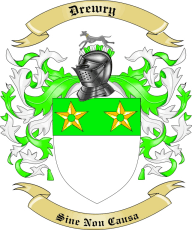 |
Drewry
|
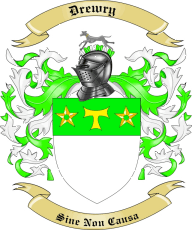 |
 |
Drewry
|
 |
|
|
Everyone, not just those of us who are in hot pursuit of our family heritage, is interested in knowing whether or not their family has been granted a Coat of Arms. The Drewrys are no exception! In my research I was fortunate to discover several different Coat of Arms from various sources. While many were similar in design several were distinct which led to the question: Which one, if any, was the authentic Arms for the Drewry family? To answer that question I turned to the College of Arms, London, England, and commissioned them to do a study on the Drewry Arms. To my surprise I found that many of the examples I had discovered each had some basis in fact for being the Drewry Arms. However, the resulting report from the College of Arms cleared up the matter once and for all. |
|
|
The Arms allowed Sir Robert Drury of Rougham, county Suffolk, are a relatively simple representation without the flare seen in many Arms, especially Royal arms. Using the keywords of the Blazon, Argent, on a Chief Vert two Mullets pierced Or, it is easy to translate into the pictured Arms: Argent indicates the color of the shield, silver, which is commonly represented as white; on a Chief, refers to a horizontal band located at the uppermost third, "the chief," of the shield; Vert, representing the color green, indicates the color of the Chief; two Mullets refer to the two five-pointed stars appearing within the Chief, and pierced Or indicates that the stars are colored gold, the color "Or," and contain two smaller circles, "pierced," allowing the underlying color of the Chief to show through. The Crest appearing above the Arms is described as: A Greyhound courant (proper) collared Or. In translating the crest's blazon we find a Greyhound dog depicted as if running full speed, "courant," with its front legs extended in front of him and his back legs extended behind him; the color of the Greyhound is natural as indicated by the wording "proper," and the "collared Or" indicates that the Greyhound is wearing a gold collar.
|
 |
|
|
 |
The Arms allowed Sir William Drury of Halsted, county Suffolk, are almost identical to the Arms of Sir Robert Drury of Rougham with the exception of the addition of the Tau Cross located between the two pierced mullets. As pictured, a Tau Cross is a cross without the upward extension. It is obvious from the similarities of the two Arms that these two families, that of Sir Robert and Sir William, were related to one another which, in fact, they were. As is shown in the record of the Heraldic Visitations, other minor variations were also recorded. One such variation records the Arms as pierced gules indicating that the color red appeared through the pierced Mullets; in another the Mullets were not pierced; and still another includes, annulets gules, red rings. Such minor variations were commonly used to identify different branches of the same family. |
|
|
The Arms pictured to the right represent one of the more fascinating depictions of the Drewry Arms discovered during my research. They represent the English Quarters which appeared in the book The History of the Family Drury in the Counties of Suffolk and Norfolk from the Conquest as commissioned by F. S. E. Drury and published by Arthur Campling in England, 1937. Mr. Drury, in commissioning this book, sought to record the history of his family and bring the armorial bearings up to date in 1933 . A. T. Butler, Windsor Herald, recorded a continuous pedigree of F. S. E. Drury's family followed from the Visitation manuscripts in which Mr. Drurys antecedents appeared. The shield is divided into 20 quarters and is set on an eight pointed Cross, most of the limbs of this appearing amongst the mantling. The reason for the presence of this eight pointed cross is that the owner of these Arms, Francis Saxham Elwes Drewry, was a Knight of Grace of the Venerable Order of St. John of Jerusalem, and it is the privilege of Knights of this Order to display their Arms on an eight pointed cross. The quartering appearing in this example can be described as the alliance between the Drewrys and other notable English families, as follows: 1) Arms of Sir Roger Drury; 2) Arms of Sir William Drury; 3) Frisell; 4) Saxham; 5) Naunton; 6) Whitwell; 7) Liston; 8) Fowler; 9) Loveday; 10) Barton; 11) Englefield; 12) Clark; 13) Rycote; 14) Garnon; 15) Lee; 16) Trollope; 17) Daubeney; 18) Daubeney Vincent; 19) Sterton, and 20) Pauncefote. |
 |
| During the course of my research I discovered several other Arms, some in books and others provided by Drewry descendants I had contacted, that were purported to be the Drewry Arms. At my request the College of Arms evaluated each of these Arms and reported back to me on their authenticity. The following pictures show these Arms. | ||
|
|
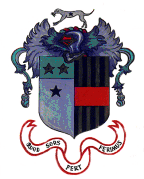 |
The Arms pictured at left were provided by William Drewry Gallalee of Richmond, Va., the grandson of Dr. William Francis Drewry who did much family research in the late 1800's and early 1900's. They were most interesting as they represent the Drewry Arms impaled (joined) with another family's Arms. As you can see, the left side of the shield is an accurate depiction of the Drewry Arms showing the Chief Vert with two Mullets pierced Or. The addition of the third Mullet indicates the Arms belonged to a son. Thus the Drewry portion of the shield is genuine. However, there is no known basis for the impalement with the Arms on the right side of the shield which cannot be positively identified. As commented on by the College of Arms: "There has been a genuine attempt to create real heraldry here and that the attempt has been quite successful and gone quite far." |
|
|
The Arms at right were found in a biography of Braxton Bragg Comer, Governor of Alabama and son of Catherine Lucinda Drewry Comer, written by Anne Kendrick Walker and published in 1947. These Arms contain a smaller shield at its center which is quartered, having Lions Rampant, one of the more impressive symbols used in Arms, in the first and last quarter. The purpose of this smaller shield, like Impalement, when the shield is divided vertically, is to represent a Drewry marriage to a heraldic heiress entitled to the Arms described by the smaller shield. Removing the smaller shield and focusing on the larger shield we find an example of the heraldry established for the Drewry name by the local heraldic authority in Ireland. Evidence of the use of this differenced heraldry for Drewry in Ireland does exist and is described as: Argent abordure Gules on a chief Vert a Cross tau Or between two Mullets Argent. By the date of this instrument, 1763, the Drewrys using these Arms had accepted that they were not entitled to the Drewry Arms as used in East Anglia and elsewhere and had petitioned from the Ulster King of Arms the opportunity to establish their own Irish Arms. While the depiction is a genuine representation of the Irish Arms granted this Drewry line it is not believed to be representative of the Drewrys in America. All of the evidence to date points directly to the descent of the Drewrys in America from the English Drewrys and not the smaller Irish faction that existed. |
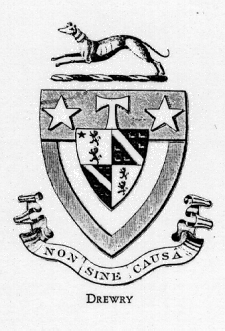 |
|
|
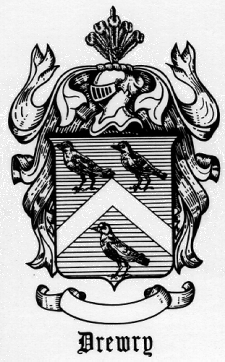 |
The Arms (pictured at left) were purchased with a short history of the Drewry name from a heraldry vendor in a shopping mall. They are not a legitimate representation of the Drewry Arms as recognized and recorded in the College of Arms' English, Scottish or Irish records. They do, however, appear in the Burke's General Armory. Described as: Azure a Chevron between three Birds Argent beaked and legged Gules with a Crest a plume of five feathers Argent the middle of enfiling a sword proper hilt pommel and blade Or. These Arms were used by a Drewry family of Brampton, county Suffolk, however, no authorities are referenced. Burke may have discovered these Arms on a tomb, a pedigree having its origin outside the College of Arms, a hall chair, a piece of jewelry or silverware, a charter or coach panel, or some other similar undocumented source. It is believed that the Drewrys bearing these Arms, perhaps in an effort to put their family on an equal par with the Drewrys of Rougham and Docking, decided to adopt for themselves the armorial bearings to which they had no right. This was easily done in the years following the end of the official Heraldic Visitations in 1690 and continued until the second half of the eighteenth century. |
|
Links to Drewry Family History pages:
Next | Previous Links to other Annie B web pages: Annie B's Homepage | Annie's Kites and Wind Things | Vacations In Paradise | Padi's Corner | Scuba Diving | Web Design Services |
|
Last updated: November, 1999 |